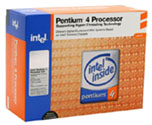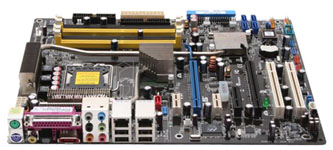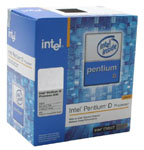Mid-Range to High-End Buyer's Guide, January 2006
by Jarred Walton on January 2, 2006 1:00 AM EST- Posted in
- Guides
Intel CPU and Motherboard Recommendations
Motherboards are just as important a component for Intel systems - possibly more so, as the lack of an integrated memory controller seems to create more variance in performance among Intel boards. The multi-GPU market for Intel systems is also more limited, as you have either NVIDIA's nForce4 SLI for Intel or Intel's own 975X, but the latter still hasn't shown up in reasonable quantities. ATI should be releasing an Intel CrossFire chipset at some point as well, but how soon that will make it to market is difficult to say. Then again, if gaming and multi-GPU configurations is your interest, there's no compelling reason to go with an Intel system right now. Higher temperatures, more noise, and lower performance for a typically higher price? That's a tough sell. Still, with the pending launch of Presler and the potential to overclock to 4.0 GHz and beyond with the proper setup, Intel systems aren't a lost cause. Personally, though, I would wait for Presler to launch before purchasing a new Intel system. Here are the current recommendations, if you're not willing to wait another month.
Intel Mid-Range Motherboard: ASUS 945P P5LD2 (775)
Price: $125 shipped
Intel Mid-Range CPU: Pentium 4 630 2MB 3.0GHz (775) - Retail
Price: $174 shipped (Retail)
Total: $299
If you're looking for a decent mid-range Intel system, the choice of processor has two good options. The first is to grab the cheapest Pentium D chip, the 820, and perhaps try your luck at overclocking. It costs a bit more, though, and not everything will benefit from multiple cores right now. We'll leave dual-cores for our high-end recommendation and stick with the slightly cheaper single-core Pentium 4 for now. Choosing between the 5xx and 6xx cores is still debatable, but the 630 comes with more cache and a slightly lower price than the 531, so we feel that it wins out.
The choice of motherboard is very difficult, as there are plenty of viable options. The best 945P/G boards actually cost more than many nForce4 SLI for Intel boards, but most of the lower end SLI boards have early revision chipsets that don't properly support the Pentium D 820 - they disable the second core. If you're sure you won't use a dual core chip in such a motherboard, they're still a good choice, but we would recommend taking the safer choice and going with an Intel chipset. The Intel chipset boards also overclock quite well, and SLI isn't a priority on a mid-range board. We've selected the ASUS 945P P5LD2, which is the "little brother" of the Deluxe board that we reviewed recently. It has good overclocking support and performance, and includes HD Azalia audio and GbE. Some of the other amenities like FireWire are missing, and the layout isn't perfect (particularly the floppy connector location, assuming you want to use a floppy), but overall it's a good board.
Intel High-End Motherboard: ASUS nForce4 SLI X16 (775) P5N32-SLI Deluxe
Price: $208 shipped
Intel High-End CPU: Pentium D 830 2x1MB 3.0GHz (775) - Retail
Price: $320 shipped (Retail)
Total: $528
For the ultimate in Intel systems, the choices are much more limited. Gigabyte's Quad Royal is not yet available (and will apparently cost a pretty penny when it hits the market), and the same can be said of 975X based motherboards. That leaves nForce4 SLI, and we went with the SLI-X16 board from ASUS. Our review found this to be the cream of the crop in the Intel enthusiast community, and it took our 840EE processor all the way to 4.1 GHz. It should also support the new Presler CPUs when they become available. Our processor choice echoes the high-end AMD pick: dual-core, moderately powerful, but don't break the bank just yet. Naturally, you can spend more money on a faster CPU (like the new 955EE) if you really want, but we would question the sanity of anyone spending $1000 just for a processor, particularly when such a part can't even sweep every benchmark. The good news is that the Intel "High-End" platform costs less than the AMD recommendation; unfortunately, the AMD is also clearly superior in performance, and not even the 955EE chip would close the gap.
Motherboard Alternatives:
If choosing a best product among AMD motherboards and processors is difficult, it's even worse in the Intel camp. Dual-core processor support is a must, even if you're not running a dual-core chip, so that means the 915/925 and earlier chipsets are out of contention. That still leaves plenty of 945G/P, 955X, nForce4 SLI, and soon-to-be-released 975X chipset boards to compare. 965 "Broadwater" boards will also launch some time in the next few months. You also have the pending launch of some new processors that may or may not work on anything but the latest 975X chipset, not to mention that Yonah and Conroe are due out next year and further complicate matters. While I don't expect the switch to socket M2 to have a major impact on AMD performance, I can't say the same for Conroe. It may match Athlon 64, it may beat Athlon 64, or it may not even match Presler. Based on Yonah performance, we can assume that Athlon 64 parity is likely, but the 4-issue core is difficult to assess without actual testing.
Anyway, you can see several alternative boards above that meet the minimum Pentium D compatibility requirement. If you're looking for a rock-solid stable motherboard, Intel's own boards like the D945PSNLK are always a safe choice. The SLI-ready boards may have issues with overclocking and/or Pentium D 820 support, as we mentioned previously, but they otherwise represent a reasonable alternative. While you may never need the second X16 slot, it certainly won't hurt to have the option, and you can always use an X1, X2, X4, or X8 card if something useful comes out with that connection type.
Motherboards are just as important a component for Intel systems - possibly more so, as the lack of an integrated memory controller seems to create more variance in performance among Intel boards. The multi-GPU market for Intel systems is also more limited, as you have either NVIDIA's nForce4 SLI for Intel or Intel's own 975X, but the latter still hasn't shown up in reasonable quantities. ATI should be releasing an Intel CrossFire chipset at some point as well, but how soon that will make it to market is difficult to say. Then again, if gaming and multi-GPU configurations is your interest, there's no compelling reason to go with an Intel system right now. Higher temperatures, more noise, and lower performance for a typically higher price? That's a tough sell. Still, with the pending launch of Presler and the potential to overclock to 4.0 GHz and beyond with the proper setup, Intel systems aren't a lost cause. Personally, though, I would wait for Presler to launch before purchasing a new Intel system. Here are the current recommendations, if you're not willing to wait another month.
 |
 |
| Click images to enlarge. | |
Intel Mid-Range Motherboard: ASUS 945P P5LD2 (775)
Price: $125 shipped
Intel Mid-Range CPU: Pentium 4 630 2MB 3.0GHz (775) - Retail
Price: $174 shipped (Retail)
Total: $299
If you're looking for a decent mid-range Intel system, the choice of processor has two good options. The first is to grab the cheapest Pentium D chip, the 820, and perhaps try your luck at overclocking. It costs a bit more, though, and not everything will benefit from multiple cores right now. We'll leave dual-cores for our high-end recommendation and stick with the slightly cheaper single-core Pentium 4 for now. Choosing between the 5xx and 6xx cores is still debatable, but the 630 comes with more cache and a slightly lower price than the 531, so we feel that it wins out.
The choice of motherboard is very difficult, as there are plenty of viable options. The best 945P/G boards actually cost more than many nForce4 SLI for Intel boards, but most of the lower end SLI boards have early revision chipsets that don't properly support the Pentium D 820 - they disable the second core. If you're sure you won't use a dual core chip in such a motherboard, they're still a good choice, but we would recommend taking the safer choice and going with an Intel chipset. The Intel chipset boards also overclock quite well, and SLI isn't a priority on a mid-range board. We've selected the ASUS 945P P5LD2, which is the "little brother" of the Deluxe board that we reviewed recently. It has good overclocking support and performance, and includes HD Azalia audio and GbE. Some of the other amenities like FireWire are missing, and the layout isn't perfect (particularly the floppy connector location, assuming you want to use a floppy), but overall it's a good board.
 |
 |
| Click images to enlarge. | |
Intel High-End Motherboard: ASUS nForce4 SLI X16 (775) P5N32-SLI Deluxe
Price: $208 shipped
Intel High-End CPU: Pentium D 830 2x1MB 3.0GHz (775) - Retail
Price: $320 shipped (Retail)
Total: $528
For the ultimate in Intel systems, the choices are much more limited. Gigabyte's Quad Royal is not yet available (and will apparently cost a pretty penny when it hits the market), and the same can be said of 975X based motherboards. That leaves nForce4 SLI, and we went with the SLI-X16 board from ASUS. Our review found this to be the cream of the crop in the Intel enthusiast community, and it took our 840EE processor all the way to 4.1 GHz. It should also support the new Presler CPUs when they become available. Our processor choice echoes the high-end AMD pick: dual-core, moderately powerful, but don't break the bank just yet. Naturally, you can spend more money on a faster CPU (like the new 955EE) if you really want, but we would question the sanity of anyone spending $1000 just for a processor, particularly when such a part can't even sweep every benchmark. The good news is that the Intel "High-End" platform costs less than the AMD recommendation; unfortunately, the AMD is also clearly superior in performance, and not even the 955EE chip would close the gap.
Motherboard Alternatives:
| Intel Motherboards | ||
| Class | Model | Price |
| Mid-Range | Gigabyte nForce4 SLI GA-8N-SLI Pro (775) | 116 |
| Mid-Range | Intel 945P D945PSNLK (775) | 117 |
| Mid-Range | MSI nForce4 SLI P4N SLI-FI (775) | 123 |
| Mid-Range | Abit nForce4 SLI NI8 SLI GR (775) | 138 |
| High-End | Abit 945P AL8 (775) | 146 |
| High-End | ASUS nForce4 SLI P5ND2-SLI Deluxe (775) | 158 |
| High-End | ASUS 945P P5LD2 Deluxe (775) | 163 |
| High-End | Abit 955X AW8 (775) | 170 |
| Ultra-High | ASUS 955X P5WD2 Premium (775) | 208 |
| Ultra-High | Gigabyte 955X GA-8I955X Royal (775) | 211 |
If choosing a best product among AMD motherboards and processors is difficult, it's even worse in the Intel camp. Dual-core processor support is a must, even if you're not running a dual-core chip, so that means the 915/925 and earlier chipsets are out of contention. That still leaves plenty of 945G/P, 955X, nForce4 SLI, and soon-to-be-released 975X chipset boards to compare. 965 "Broadwater" boards will also launch some time in the next few months. You also have the pending launch of some new processors that may or may not work on anything but the latest 975X chipset, not to mention that Yonah and Conroe are due out next year and further complicate matters. While I don't expect the switch to socket M2 to have a major impact on AMD performance, I can't say the same for Conroe. It may match Athlon 64, it may beat Athlon 64, or it may not even match Presler. Based on Yonah performance, we can assume that Athlon 64 parity is likely, but the 4-issue core is difficult to assess without actual testing.
Anyway, you can see several alternative boards above that meet the minimum Pentium D compatibility requirement. If you're looking for a rock-solid stable motherboard, Intel's own boards like the D945PSNLK are always a safe choice. The SLI-ready boards may have issues with overclocking and/or Pentium D 820 support, as we mentioned previously, but they otherwise represent a reasonable alternative. While you may never need the second X16 slot, it certainly won't hurt to have the option, and you can always use an X1, X2, X4, or X8 card if something useful comes out with that connection type.










67 Comments
View All Comments
Yawgm0th - Monday, January 2, 2006 - link
Why restrict the display choices to LCDs that can't handle 1600x1200 and then complain about Crossfire only being able to support 1600x1200@60Hz. If you're willing to and would prefer to use an LCD, then how can you justify complaining about a shortcoming of Crossfire that can't possibly bother you?I'm not in favor of Crossfire or even opposed to LCDs (though I certainly prefer CRTs when mobility is not needed), but it would be nice to have some consistency.
JarredWalton - Monday, January 2, 2006 - link
As I suggested, Crossfire is a high-end option, and my high-end display choice is definitely going to want the new X1800 CF and not the X800 variant. I don't recommend SLI *or* Crossfire for a Mid-range system. I mean, $400-$500 gets you an X800 CF setup or a 6800GS SLI setup... or you can just get a single 7800GTX or X1800XT. Then you don't need to worry about CF/SLI profiles, improperly optimized games, etc. and you can always add a second card later if you change your mind.ImJacksAmygdala - Monday, January 2, 2006 - link
If I'm going to spend >$300 on a new monitor I atleast want it to be future proof with HDCP...JarredWalton - Monday, January 2, 2006 - link
THere is no way Microsoft or anyone else is going to force HDCP on us with Vista. Quick, name all the HDCP compliant displays out on the market. Um, there aren't any, at least outside of the HDTV world, right? MS knows that ALL of the market currently runs non-HDCP displays, so they would be completely insane to require everyone to buy a new monitor.DigitalFreak - Monday, January 2, 2006 - link
Wait a couple more weeks, and you can get the Dell 3007. 30" widescreen with specs comparable to the Apple 30" cinema display. No word on price yet, but I'm betting it will be quite a bit less than the Apple.JarredWalton - Monday, January 2, 2006 - link
There's also the 2407FPW coming out soon. I imagine the 30" display will be firmly in the "Dream" category, but I'm curious to see where the 2407 gets priced. It should be a bit cheaper than the 2405 to manufacture, but with higher specs it could still end up costing significantly more.Pythias - Monday, January 2, 2006 - link
I know you folks mean well, but cut the guy a little slack or else write your own guide.I believe the purpose of this article and its predecessors is to offer suggestions for people who have difficulty choosing components.
As Jarred said, This guide is not written in stone. Rather, it is merely a template subject to the individual's discretion.
tomchae - Monday, January 2, 2006 - link
these had the best feedback in newegg. are these good?-ABIT KN8 Ultra Socket 939 NVIDIA nForce4 Ultra ATX AMD Motherboard $99
http://www.newegg.com/Product/Product.asp?Item=N82...">http://www.newegg.com/Product/Product.asp?Item=N82...
-ASUS A8N-SLI Socket 939 NVIDIA nForce4 SLI ATX AMD Motherboard $122
http://www.newegg.com/Product/CustratingReview.asp...">http://www.newegg.com/Product/CustratingReview.asp...
bob661 - Monday, January 2, 2006 - link
I can definitely recommend the Asus board. Rock solid.JarredWalton - Tuesday, January 3, 2006 - link
Honestly, these days it's easier to come up with a short list of motherboards I *wouldn't* buy rather than ones that stand out as exceptional - and that goes double for socket 939 boards. There are very few boards out there that I would absolutely avoid. I just cut off my "alternative" list at a few boards from each price range; there are plenty of others (including ASUS, MSI, EPoX, Abit, etc.) that will work well.